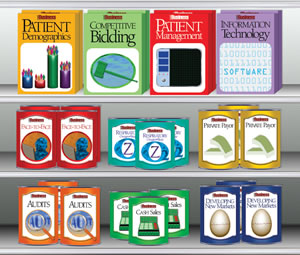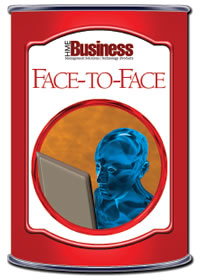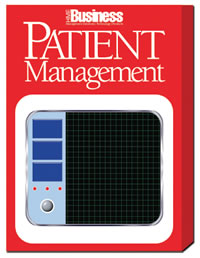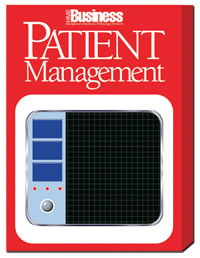2014 Preview
Big Ten
Our seventh annual look at the 10 key trends that will define 2014, and how providers should approach them.
- By David Kopf
- Jan 01, 2014
 It’s time once again for HMEB’s Big Ten, in which we review the trends, challenges and opportunities that will define the next 12 months. Suffice it to say that this industry isn’t short on inventory when it comes to change. A variety of regulatory and marketplace factors are influencing how HME owners and operators run their businesses, but we’ve landed on 10 key items that we are positive will define 2014. They are:
It’s time once again for HMEB’s Big Ten, in which we review the trends, challenges and opportunities that will define the next 12 months. Suffice it to say that this industry isn’t short on inventory when it comes to change. A variety of regulatory and marketplace factors are influencing how HME owners and operators run their businesses, but we’ve landed on 10 key items that we are positive will define 2014. They are:
- Competitive Bidding
- Audits
- Face-to-Face
- Patient Demographics
- Respiratory
- Retail Sales
- Developing New Markets and Business Models
- Private Payor
- Information Technology
- Patient Management
So, without further ado, let’s dive right into each of the Big Ten items and see what they promise for the year to come, and how providers should prepare.
 Competitive Bidding
Competitive Bidding
Bar none, the single largest factor impacting the home medical equipment industry is competitive bidding. Let’s take a quick look back at the past year to see how today’s stage was set.
With Round Two of competitive bidding, the bid amounts were announced in the beginning of the year, and they were not pretty. For DME, reimbursement rates were cut by an average of 46 percent. For the national mail-order component of the program, rates were whacked by 72 percent. These massive cuts left many wondering who exactly would be the winners when the contracts were announced — the providers who received contracts or the providers who were cut out of categories or competitive bidding areas they had been serving for years.
Then in April the suppliers were announced, and almost immediately a simple review of the contract holders showed that high percentages of winning providers did not have proper state certifications or licenses to provide services in the CBAs they had been awarded. Moreover, many didn’t even have a physical location, and in some cases it was plainly evident that contracts had been awarded to providers that clearly had no real capabilities to serve the patients they were intended to serve.
To most observers it became plainly evident that some businesses had gamed the bid system, and that CMS had not engaged in the thorough vetting of bidding providers that it had provided. But when the industry approached a lawsuit based on this reality, it became clear that CMS, through the Medicare Modernization Act of 2003, had the latitude to enforce and interpret the rules however it wanted.
Then on July 1, CMS implemented the program, meaning that if providers truly wanted to stop the program, they would need to concentrate on legislative efforts to stop the program. The main approach was in support of H.R. 1717, a bill that would replace the competitive bidding program with the industry’s Market Pricing Program alternative. The MPP uses various recommendations made by economists, such as the University of Maryland’s Prof. Peter Crampton, to create a system that fixes the central flaws in CMS’s bid program.
As of press time, that bill was up to 162 co-sponsors, which means the industry has more lobbying work to do in that regard. However, another surprising development occurred just as this issue was going to press: for the first time since 2008, members of the Senate Finance Committee worked to attach competitive bidding reforms based on the MPP to the to the sustainable growth rate (SGR) reform bill, also known as the “doc fix.” So, providers face the New Year at a pivotal point of change in their industry: will they have finally stopped the beast that had just begun chomping down on their industry, or will they still need to find a way out of its maw? The answer to that question will define 2014.
 Audits
Audits
For nearly three years, providers have had a crash course in dealing with RAC, CERT and ZPIC audits, and the lesson hasn’t been pretty. That said, providers are learning their lessons. They have learned how to educate their referral partners and work with them to ensure that claims have unimpeachable documentation. And if a question comes from auditors, providers have put into place tools and processes that let them respond quickly with the right documentation. And, if an auditor does move to recoup, providers are increasingly become adept at appealing audits and overturning those recoupments with a high rate of success.
But, CMS has reported more than once that it is enjoying enough success with the program to expand it even further. This means that providers can expect more of the same in 2014, and perhaps worse. According to the experts, the RAC program is going to be expanded in DME; O&P is likely to be reviewed by supplemental medical review contractors; and the work being done by zone program integrity contractors will be shifted into a new undertaking called the unified program integrity contractor, and that will include reviewing Medicaid claims.
However, audits are becoming a reality for a wider number of healthcare professionals. This could make HME providers’ lives easier in terms of working with referral partners that are difficult sources of documentation. For instance, physicians that don’t comply with providers’ documentation requests could likely open themselves to MAC and RAC reviews in the year to come.
But no matter how they slice it, there isn’t exactly an upside to CMS’s audit onslaught. The year to come will see CMS’s program integrity efforts become further entrenched. This means providers dealing with Medicare will need to build business processes that approach every claim as though it is going to be audited, and that therefore its documentation must be airtight and not open to interpretations. This environment will be the “new normal” for 2014, and providers will need to strive to adhere to it, while minimizing the cost these new workflows and procedures will have on their operations.
 Face-to-Face
Face-to-Face
The worst part about audits was that most providers did not see them coming or realize their impact. Roughly three years ago, CMS audits were the surprise factor that began to radically alter the HME landscape. Eventually, providers realized that audits posed just as big a threat to their patients and livelihoods as competitive bidding did. While competitive bidding threatened their businesses on the front end, CMS’s massive ramping up of audits threatened to do so on the back end.
Now providers are facing a similar dilemma with CMS’s face-to-face requirement. While face-to-face is familiar territory for providers of complex rehab, CMS has expanded the requirement to many DME product codes well beyond mobility. Now the agency requires that physicians meet face-to-face with patients on a myriad of items, and properly document those face-to-face meetings so that the claims for those DME items will pass muster.
That’s a big “ask” for providers and their referral partners, who are already time strapped and burdened by a wide variety of documentation requirements. Furthermore, it’s a big “ask” for a nation of physicians and providers who are largely unprepared to fulfill CMS’s requirement. So, CMS postponed enforcement of the requirement from July 1 to October 1.
When HMEB polled its online readers last September, only 7 percent said that both their businesses and referral partners were prepared for the face-to-face requirement; 63 percent said their businesses were prepared, but their referrals weren’t entirely prepared; and 29 percent said neither their businesses, nor their referrals were fully prepared. So, 93 percent (give or take a percentile) of the referral partners with whom providers work needed serious education on the requirement.
Not surprisingly, just before the October enforcement date came due, CMS punted it into 2014, without outlining a specific date. However, it did make one very important stipulation: while enforcement was postponed, the implementation still stood. This essentially means that providers and their partners need to be working as though the requirement is in effect, because, well, it is in effect. (To read more about what providers need to be doing right now to be compliant with the face-to-face requirement, turn to “The Face-to-Face Countdown” on page 25.)
CMS then followed up that announcement by stating that while enforcement for face-to-face was delayed, implementation and enforcement dates for the written order prior to delivery (a requirement paired with the face-to-face requirement) had never shifted, which sent many providers scurrying. (See “News, Trends & Analysis,” on page 8, to read more.)
Regardless, at least the first half of 2014 will see providers fixated on ensuring that they have the right procedures and practices in place and have undertaken the necessary education efforts to ensure that their referral partners are conducting face-to-face meetings with patients, and properly documenting those meetings to ensure medical necessity for a whole swath of DME. This is sure to add complexity and expense to their businesses at a time when reimbursement is at historic lows. How they manage and minimize that impact will be pivotal to their performance in the coming months.
 Patient Demographics
Patient Demographics
There are two demographics trends that have made it onto past Big Ten lists, and will continue to impact the HME industry in 2014: an aging United States, and our nation’s obesity epidemic. These two massive demographic shifts are influencing what providers do, how they do it, and how they get paid for it.
Let’s take them in reverse, starting with an overweight America. The trend is staggering: approximately 35.7 percent of adults and 17 percent of children are obese, according to the Centers for Disease Control. Other studies published over the last year warn that by 2020, Americans could reach an obesity rate of 75 percent to 80 percent. Furthermore, some studies put the population of patients either weighing 300 pounds or more, or with a body mass index of 40 or more, as high as 9 million people. Ultimately, according to at least one study, obesity leads to the deaths of 300,000 Americans each year.
And those bariatric patients can suffer from a number of co-morbidities, such as hypertension, obstructive sleep apnea, adverse lipid concentrations, pressure ulcers, and Type Two diabetes. These are all conditions that providers can and should help treat through a variety of DME. Moreover, given the risk for falls and other access-related injuries in and around the home, providers should be offering bath safety and home access-related solutions to these clients. The net-net is that once again, bariatric patients will be a key business and care segment for providers in 2014.
Similarly, seniors represent another impossible-to-ignore patient population. The population of seniors is massive and growing. According to the Census Bureau, there were 40.3 million people age 65 and older in the United States in 2010, which was up 5.3 percent from 35 million in 2000. Moreover, with the 77 million-person-strong Baby Boom well into retirement, the AARP now reports that by 2030 one in every five Americans will be age 65 or older.
Most providers are already serving seniors in their businesses, as older Americans form the cornerstone of many HMEs’ clientele. They provide seniors with products related to their therapy (such as oxygen equipment), as well as bath safety items, aids to daily living and other products. However, providers need to get more creative about how they serve these older patients.
For instance, many providers are ignoring the obvious business opportunity of tapping into the senior care marketplace. Senior care offers an excellent opportunity to serve a patient group providers know inside and out with a whole new range of profitable services. And senior care offers more than one entry point into the marketplace either through partnering up with or serving existing senior care businesses, or by starting their own. Providers have the patient relationships; now is the time to make the most of them.
The bottom line is that riding the gravy train of a statistical trend is not enough. Especially considering that CMS is trying to derail that train. As these patient demographics continue to define providers’ businesses, those providers must work over the next 12 months to maximize the opportunities those patient populations offer.
 Respiratory
Respiratory
As always, respiratory services remain a key element in the HME industry. Oxygen providers have demonstrated that despite cuts and even massive upendings of their business models, such as the 36-month rental cap, those providers can survive and thrive. But 2013 saw two significant changes.
First off, competitive bidding Round Two was implemented. This meant many oxygen providers lost entire areas of service, or at the very worst lost the entire category of oxygen from their businesses. This is a significant setback, as many of those providers focus their businesses on their oxygen services, before other offerings.
Second, it appears the oxygen business is flattening. Despite the fact that the population of COPD patients continues to grow and grow as the realization that the disease is heavily underdiagnosed continues to reverberate around the medical community, the declining reimbursement, along with audits has caused little to no growth to occur in the respiratory segment of DME.
This means respiratory providers that are starting the year with a significant chunk of their business missing, or soon to run out, will need to look at new strategies for driving revenue. To be
certain, there are other sources for reimbursement. For instance, private payor insurance offers an alternative, but it’s important to note that private carriers tend to match Medicare reimbursement.
Also, Medicare Advantage, Medicaid, hospice, long-term care and retail sales could help those providers tap into previously unexplored tracting viable, Round Two could play out differently due to its near national scale (with the exception of some rural areas). Given the cost of respiratory services, some oxygen providers could find a mutually beneficial way to subcontract.
Time will tell what works and what doesn’t in the respiratory space. And, to be sure, we will see some consolidation among oxygen providers as 2014 progresses. If anything, how oxygen providers fare in the year to come could well demonstrate what the rest of the industry experiences.
 Retail Sales
Retail Sales
While countless industry experts have been beating the retail sales drum for several years, it seemed that 2013 was the year where providers really sat up and realized they had better start marching to the beat.
The argument is simple: Medicare is cutting reimbursement to ridiculous degrees, and providers need to find some way to buttress their cash flow as a result. Retail sales offers an excellent way to accomplish that, because they are straightforward cash transactions that don’t involve Medicare, private payor insurance carriers or anyone else — only the provider and the patient are doing business in a retail transaction.
Retail sales items appeal to a wide variety of patients and take a variety of forms. For instance, bath safety items, home access products and aids to daily living offer a wide variety of appeals to patients that are already coming into the store for other items. Whether retail sales items are impulse buys or are actively sought, it’s clear they are part of the spectrum of products providers need to serve up to their patients.
And this creates unique merchandising challenges and opportunities for providers: how can they best create the right product mix for their patients, and how do they properly serve them up on the showroom floor? Now providers will need to carefully consider how they pair retail and funded items so as to encourage the optimal uptake. Additionally, setting up engaging signage and displays will also be critical.
Likewise, providers will need to hone their retail sales and marketing strategies and staff acumen. They will need to consider the appeals that resonate with the different segments of their customers and patients, and determine which venues — print, social media, email, web, print, and even TV and radio — will spread awareness and drive interest and traffic to the store. And once those patients get to the store, staff will need to know how to sell their retail wares. Moreover, they will need to be comfortable with the concept of selling and understand how and why it does not conflict with the care-related aspects of their jobs.
Also, from a back office standpoint, providers will need to carefully work to tie their funded workflows and infrastructure to their retail workflows and infrastructure. How will they manage inventory? Will they be able to promote based on patient records and habits? Will they be able to tie retail promotions to re-supply items for funded items, for example? These are the sorts of questions providers will be asking and answering in 2014.
 Developing New Markets and Models
Developing New Markets and Models
But cash sales can’t carry it all. While retail sales will be critical in maintaining provider cash flow, it is not a panacea for all Medicare-related funding setbacks and other trends impacting the home medical equipment space.
Looking at these factors, it is clear that the word “reinvention” will define 2014 for many providers. If anything, the providers of the future will be highly diversified and blended organizations that will develop niche or unique expertise to serve a much wider range of patients, referral partners and other customers than yesterday. Gone is the 80/20 split of Medicare funding and everything else. Now providers will have to look at their care expertise, their product expertise, their local area, and demographics to tailor their business to their markets. And they will have to regularly monitor their market to prepare for any unforeseen shifts, as well.
Moreover, providers will likely find themselves tapping into new business opportunities that might push them out of their comfort zones, but help them establish whole new business models that leverage DME market opportunities either safe or well insulated from CMS’s financial scalpel (or hatchet, as it were). Some examples:
Home access: Home access is unique in that it lets providers build a whole new business around the patients that they already serve. Mobility patients, bariatric patients, seniors and others already coming to providers for DME need help safely using their homes. As a result, offering home access and bath safety solutions is a “natural” business opportunity. Moreover, because of the spectrum of products and the professional education and certification available from organizations such as VGM’s Accessible Home Improvement of America (AHIA), they can build that business and tap into new referral sources and partners in a logical, linear fashion.
Senior care: As mentioned under “Patient Demographics,” there is a massive senior population that many providers are already serving. So why not expand the business, add new staff, and begin providing senior care and home care services to seniors? Or, at the very least, providers can begin serving the constantly growing number of facilities-based and residential senior living providers with DME and related services.
Orthotics and prosthetics: Another opportunity that lets providers build on relationships they might already have is O&P. While there are considerable expertise and hard assets they have to add to their business to take advantage of O&P, it does represent a solid opportunity for business expansion to a provider willing to make the commitment. Moreover, increasing funding constraints in the O&P world might work to providers’ strategic advantage, given the expertise they’ve developed in dealing with audits and reimbursement cuts in the DMEPOS world.
Wound care: Wound care is another niche that providers could expand into that would help them build off of existing business relationships with physicians, as well as tap into new business relationships with facilities such as wound centers. For a provider, that means offering therapeutic support surfaces, adding staff that understand the spectrum of wound care treatment offerings, such as NPWT, enteral nutrition, compression, support surfaces, and of course dressings.
 Private Payor
Private Payor
As part of providers’ efforts to build new business models, private payor insurance carriers are going to have to become an increasingly important component of their game plans. As CMS has continued to chip away at reimbursement, many providers have worked to increase the percentage of their revenues that is derived from private payor reimbursement. Where five years ago, those providers might not have concentrated much attention on private payors, now it is a key element in their strategies.
Moreover, as providers diversify their reach and business strategies in the months to come, they will be reaching out to different payor sources. No matter how they slice it, private payor reimbursement will increasingly become an important element of their revenue stream.
But private payor funding is not a simple solution. For starters, private payor reimbursement tends to match Medicare reimbursement rates, which means that insurance carriers don’t necessarily represent fatter revenue sources, but rather alternative funding. Likewise, consolidation among insurance carriers is another trend that is sure to push down reimbursement rates.
Also, some major private payor insurers, such as Humana, have entered into single-provider relationships with large national HME providers as they try to drive down their cost structures, which makes the landscape that much more difficult. That said, it is also likely that those larger national providers will look to subcontract services for certain categories and geographic areas. So there are still opportunities to be had.
But no matter how you slice it, private payors are revenue sources that cannot be ignored, and that means providers will have to be prepared, and at a strategic level. In addition to ensuring they have the right accreditation for private payors, and following the right billing protocols, simply establishing solid relationships with private payor insurance will require providers to do some very high-level deal making. The management and ownership level will very likely need to develop highly individualized sales and marketing appeals for each insurance company to ensure they can gain the right traction. Moreover, they will be dealing with higher-level decision makers, which means they will need to enlist the right expertise within their sales organizations.
 Information Technology
Information Technology
Since our debut as HME Business, this publication has been singing the praises of software and information technology as a critical element in HME business management — and for good reason. Information is a tool, and perhaps the best tool, for insulating an HME provider business from the difficult funding environment that CMS has created. While CMS does its level best to hack away at reimbursement rates, providers have been able to leverage the efficiencies they gain through software systems to increase their efficiency and drive down their cost models.
IT-savvy providers can use inventory innovations such as barcoding and automatic reordering to ensure that they have just the right supply of key DME items, while not filling up the warehouse with expensive equipment that winds up collecting dust and costing money. They can use GPS and smart route planning to better manage their delivery and technician fleets to ensure they minimize cost while maximizing timeliness and responsiveness. Providers can also set up “dashboard” views that let them view key business and operation performance metrics at a glance to ensure each department is performing adequately, and use reporting tools to determine why, if they are not.
And of course, technology is helping providers keep pace with claims and documentation changes to ensure that claims are clean and will pass muster when it comes to CMS audits. Many systems are set up to establish a claims processing workflow that will not permit a claim to progress until it is 100 percent correct. In fact, there are even systems and services that will help their referral partners through key steps in the documentation process to ensure what they return to the HME provider is correct. And, if auditors have a question about a claim, providers can leverage document imaging and management to quickly retrieve and share the necessary documentation.
Software will also continue to help providers leverage new revenue generating opportunities as well. For instance, many HME software systems offer robust retail sales support, with some even supporting specific point of sales systems that are directly tied to their existing inventory systems and patient records.
Now, there has been some consolidation among the systems available to providers over the past year. HME software maker Brightree LLC has acquired MedAct LLC, and Mediware Information Systems Inc. acquired Fastrack Healthcare Systems Inc., as well as Definitive Homecare Solutions Ltd., which brought with it the well-known CPR+ system. But these mergers should not limit providers’ ability to use technology to their advantage. If anything, given that some of these systems leverage their user bases to provide additional tools, such as benchmarking, some consolidation could work to providers’ benefit.
Ultimately, as the HME landscape becomes increasingly complex over 2014, information technology will be there to help providers make sense of and adapt to the changes they face.
 Patient Management
Patient Management
One trend universal to healthcare as a whole is a continued emphasis on patient outcomes. As members of the HME industry know, accountable care organizations (ACOs) are quickly gaining steam. ACOs are groups of healthcare providers that provide end-to-end healthcare solutions that focus on the “prime directive” of driving optimal patient outcomes for the lowest price. And while Medicare did not specifically create the phrase ACO, it established guidelines establishing ACOs in the 2010 Patient Protection and Affordable Care Act. The Act lets CMS set up the Medicare Shared Savings program, which lets it extend contracts to ACOs to provide services to Medicare Part A and Part B beneficiaries. In terms of number, Medicare has reported that there were 32 ACOs in December 2011; 27 ACOs in April 2012; 88 ACOs in July 2012; and 106 in January 2013. All told, there are nearly 350 ACOs across the country.
So what do ACOs have to do with HME? They are pointing to where the marketplace is going: If Medicare continues to set the state for the rest of healthcare, it is likely that healthcare professionals throughout the healthcare continuum will look for partners who can help them ensure the best outcomes for the best price. And this provides HME businesses with a key opportunity: if they can create services that help better manage the care patients receive, then they will position themselves as a key player in the healthcare process.
This is where patient management fits in. Providers of sleep therapy equipment are blazing trails in this regard. Using a variety of communications methods and remote monitoring innovations, they are able to serve as an information conduit to the physicians and other sleep professionals involved in sleep patients’ care. Thanks to technology, the sleep provider can provide up-to-the-minute reports on how a sleep patient is faring through the night and whether or not his or her PAP therapy needs adjustment. Moreover, through a blend of automated and live communications methods, they can consult with patients and even ensure they are ordering re-supply items, such as masks.
As the emphasis for accountable, outcomes-oriented healthcare continues to grow, providers can leverage patient management strategies and technologies to position themselves as lynchpins in ensuring optimal outcomes and cost models for patients and partners, alike.
This article originally appeared in the January 2014 issue of HME Business.